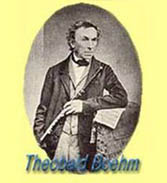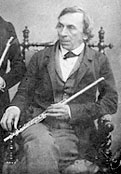
Theobald Boehm (1794-1881) a Bavarian Court musician and industrial innovator designed completely new types of flute in 1832 and 1847. Developments of the second design by French makers, later copied by Americans and Japanese, formed the basis of the modern flute. Until 1831 Boehm built and performed on eight-keyed flutes. But on a visit to London he met others interested in devising new acoustical models for the flute that used mechanical means to alter its fingering. He quickly devised the model shown below, which used interlinked rod-axles to transmit the motion of fingers to remote tone holes. This allowed him to break out of the acoustical framework imposed by the flute`s traditional design. On returning to his workshop in Munich, he built another conical-bored wooden flute, shown below. This ring-key or `conical Boehm` flute began to attract notice when a few prominent players in Paris (1838) and London (1840) took it up, but it was also criticised because, with its new and unfamiliar construction, it sounded to some people more like a trumpet than a flute. In 1847 Boehm devised a second model, that replaced the flute`s conical bore with a cylindrical one, and its wooden tube with one of metal. The metal cylinder flute was immediately licensed for manufacture, in altered forms, in Paris and London, though some flutists, particularly in Germany, thought its tone even less flute-like than that of the ring-key flute. Partly for this reason, until the early 20th century the cylindrical Boehm flute was made in wood more often than in metal.
Theobald Boehm, a Bavarian goldsmith, flutist, composer, and industrialist, invented the type of flute that became the basis for the modern instrument a little more than a century and a half ago. Between 1821 and 1831 Boehm traveled throughout Europe on concert tours, often performing his own compositions and, from 1828, playing on flutes made in his own workshop in Munich. On a visit to London in 1831 he constructed an experimental flute that gave the fingers new mechanical means to control holes placed beyond their reach. He refined the concept of his new flute in the following year, and the "ring-key" flute of 1832 was taken up by a few promient performers in Paris and later officialy adopted at the brussels Conservatoire. Boehm devised a metal flute with a new cylindrical bore in 1847, using a similar mechanism to that of the 1832 flute. His first metal cylinder flute (No. 1, 1847, Dayton C. Miller Collection) is pictured here. Modified Boehm flutes by French makers became the official instrument of the influential Paris Conservatoire in 1860. The French pattern was later adopted by American workshops and thus became the standard form of the modern flute. Changing ideals of tone and intonation led to further changes in the mid-20th century.
goldsmith, flutist, composer, and industrialist, invented the type of flute that became the basis for the modern instrument a little more than a century and a half ago. Between 1821 and 1831 Boehm traveled throughout Europe on concert tours, often performing his own compositions and, from 1828, playing on flutes made in his own workshop in Munich. On a visit to London in 1831 he constructed an experimental flute that gave the fingers new mechanical means to control holes placed beyond their reach. He refined the concept of his new flute in the following year, and the "ring-key" flute of 1832 was taken up by a few promient performers in Paris and later officialy adopted at the brussels Conservatoire. Boehm devised a metal flute with a new cylindrical bore in 1847, using a similar mechanism to that of the 1832 flute. His first metal cylinder flute (No. 1, 1847, Dayton C. Miller Collection) is pictured here. Modified Boehm flutes by French makers became the official instrument of the influential Paris Conservatoire in 1860. The French pattern was later adopted by American workshops and thus became the standard form of the modern flute. Changing ideals of tone and intonation led to further changes in the mid-20th century.
Theobald Boehm, a Bavarian
 goldsmith, flutist, composer, and industrialist, invented the type of flute that became the basis for the modern instrument a little more than a century and a half ago. Between 1821 and 1831 Boehm traveled throughout Europe on concert tours, often performing his own compositions and, from 1828, playing on flutes made in his own workshop in Munich. On a visit to London in 1831 he constructed an experimental flute that gave the fingers new mechanical means to control holes placed beyond their reach. He refined the concept of his new flute in the following year, and the "ring-key" flute of 1832 was taken up by a few promient performers in Paris and later officialy adopted at the brussels Conservatoire. Boehm devised a metal flute with a new cylindrical bore in 1847, using a similar mechanism to that of the 1832 flute. His first metal cylinder flute (No. 1, 1847, Dayton C. Miller Collection) is pictured here. Modified Boehm flutes by French makers became the official instrument of the influential Paris Conservatoire in 1860. The French pattern was later adopted by American workshops and thus became the standard form of the modern flute. Changing ideals of tone and intonation led to further changes in the mid-20th century.
goldsmith, flutist, composer, and industrialist, invented the type of flute that became the basis for the modern instrument a little more than a century and a half ago. Between 1821 and 1831 Boehm traveled throughout Europe on concert tours, often performing his own compositions and, from 1828, playing on flutes made in his own workshop in Munich. On a visit to London in 1831 he constructed an experimental flute that gave the fingers new mechanical means to control holes placed beyond their reach. He refined the concept of his new flute in the following year, and the "ring-key" flute of 1832 was taken up by a few promient performers in Paris and later officialy adopted at the brussels Conservatoire. Boehm devised a metal flute with a new cylindrical bore in 1847, using a similar mechanism to that of the 1832 flute. His first metal cylinder flute (No. 1, 1847, Dayton C. Miller Collection) is pictured here. Modified Boehm flutes by French makers became the official instrument of the influential Paris Conservatoire in 1860. The French pattern was later adopted by American workshops and thus became the standard form of the modern flute. Changing ideals of tone and intonation led to further changes in the mid-20th century.il écoute, es hört